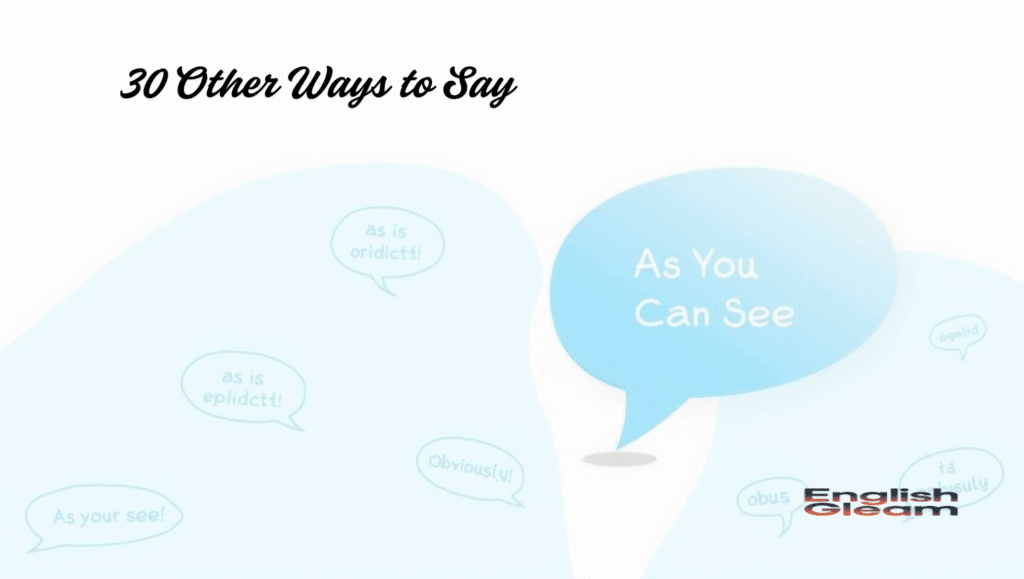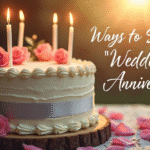“As you can see” is used to guide attention.It helps point out something clear or shown.But saying it too often can sound dull or stiff.
Want to sound more natural or polite?There are better ways to say the same thing.Some are friendly, others more formal.
This list gives 30 great alternative phrases.Each one comes with meaning and examples.Use them in talks, emails, or writing at work.
Why Replace “As You Can See”?
“As you can see” is commonly used in:
- Presentations to point out visuals
- Emails and reports to emphasize results
- Daily discussions to highlight something obvious
But relying on it too often may weaken your message. Why? Because it can sound:
- Overly obvious
- Impersonal
- Slightly patronizing
Using a variety of polite alternatives boosts your tone, improves your delivery, and helps you articulate a message in a way that keeps the audience engaged.
Quick Table: 30 Substitutes for “As You Can See”
| Alternative Phrase | Best Context | Tone |
|---|---|---|
| Clearly | Data-driven insights | Assertive |
| Evidently | Analytical reports | Formal |
| As demonstrated | Technical presentations | Professional |
| This shows that | Storytelling, persuasive writing | Friendly |
| Notice that | Instructional tone | Warm |
| As illustrated | Visual support | Structured |
| From this, it’s clear | Conclusion-based writing | Reflective |
| Obviously | Obvious outcomes | Direct |
| Looking at this | Walkthroughs | Conversational |
| It’s apparent that | Formal writing | Objective |
| Based on this | Logical analysis | Matter-of-fact |
| As indicated | Reports and documentation | Neutral |
| As revealed | Trend analysis | Insightful |
| You’ll observe that | Educational tone | Courteous |
| This indicates | Professional writing | Analytical |
| It’s easy to see that | UX, design explanation | Friendly |
| From the data | Charts and stats | Evidence-based |
| Take note of | Tutorials, training | Directive |
| It’s visible that | Design, visual presentations | Observational |
| This confirms that | Decision-based context | Definitive |
| You’ll notice | Emails, casual explanation | Polite |
| As reflected here | Report visuals | Polished |
| Observe that | Academic context | Formal |
| You can tell that | Storytelling, casual tone | Relaxed |
| In light of this | Strategic planning | Thoughtful |
| As it turns out | Narrative writing | Reflective |
| What this shows | Persuasive communication | Clear |
| It’s quite evident | Formal, confident tone | Assertive |
| This makes it clear | Summarizing or concluding | Conclusive |
| As shown here | When visuals are referenced | Supportive |
Tone Guidance: Matching Expression to Mood
Not every synonym fits every situation. Here’s how to choose:
- For formal writing: Use “evidently,” “as indicated,” or “this indicates”
- In presentations: Go with “as demonstrated,” “as shown here,” or “notice that”
- For everyday conversations: Try “you can tell that” or “obviously”
- To build meaningful communication: Choose “this shows that” or “from this, it’s clear”
The right tone helps you connect better, whether it’s business correspondence, academic writing, or casual chats.
Top 5 Alternatives Explained with Examples
1. Clearly
Best for: Presenting strong data or obvious results
Example: Clearly, sales jumped after the rebranding.
Why it works: Simple, confident, and to the point.
2. As illustrated
Best for: Visual or infographic reference
Example: As illustrated in the chart, customer retention increased.
Why it works: Polished and ideal for guiding attention in a business setting.
3. You’ll notice
Best for: Gentle, polite instruction
Example: You’ll notice the design now uses warmer colors.
Why it works: Friendly tone suitable for professional communication and design feedback.
4. From this, it’s clear
Best for: Drawing conclusions without sounding pushy
Example: From this, it’s clear our strategy paid off.
Why it works: Reflective tone that’s helpful in conclusion-based writing.
5. In light of this
Best for: Making decisions or reflecting on results
Example: In light of this, we’ll adjust our budget allocation.
Why it works: Feels thoughtful and professional.

When to Use These Phrases (And When Not To)
| Phrase | Use When… | Avoid When… |
|---|---|---|
| “Clearly” | Backed by strong evidence | There’s ambiguity |
| “Obviously” | Point is truly self-evident | Tone might sound dismissive |
| “As illustrated” | Supporting visuals exist | There’s no visual support |
| “This shows that” | You want to guide inference gently | There’s no strong logic to support conclusion |
| “From this, it’s clear” | Wrapping up or summarizing data | Data is vague or inconclusive |
Bonus Tips to Upgrade Your Communication
- Don’t repeat the same phrase. Mix things up to maintain a natural flow.
- Check the tone. Respectful variations work better than commanding tones.
- Use analogies. To make a point clearer, compare it with something familiar.
- Add visual cues. Tables, bullets, and highlights help your audience absorb the message.
Real-Life Example Paragraphs
Before (Repetitive):
As you can see, the report shows growth. As you can see, the team improved. As you can see, profits rose.
After (Natural and Varied):
The report clearly shows growth. You’ll notice the team improved across all metrics. From the data, profits are steadily rising.
FAQs
1. What is a better way to say “as you can see” in a presentation?
Try “as shown here,” “notice that,” or “from this chart.” These capture observation without sounding forced.
2. Is “as you can see” rude or unprofessional?
Not always, but it can be. Especially if it implies the listener missed something obvious. Use more polite alternatives like “you’ll notice” or “as illustrated.”
3. Which alternatives work best in business communication?
“This confirms that,” “based on this,” and “as indicated” are professional substitutes that align well with corporate tone.
4. Can I use these in academic writing?
Absolutely. “Evidently,” “as demonstrated,” and “this indicates” are great for structured writing and formal documentation.
5. What should I use in everyday conversations?
Try casual expressions like “you can tell that” or “it’s easy to see that.” They help maintain a relaxed tone.

Final Thoughts: Say It Better, Say It Smarter
Saying “as you can see” too often can sound boring or too formal. Using the right variation makes your message feel more natural.
These 30 other ways help you express a point clearly. Choose the best one for your tone—whether casual, polite, or professional.

William Jams is an experienced blogger at EnglishGleam, passionate about language, writing, and storytelling. With years of expertise in crafting engaging content, she aims to inspire readers through insightful articles that enhance their English skills and knowledge.






